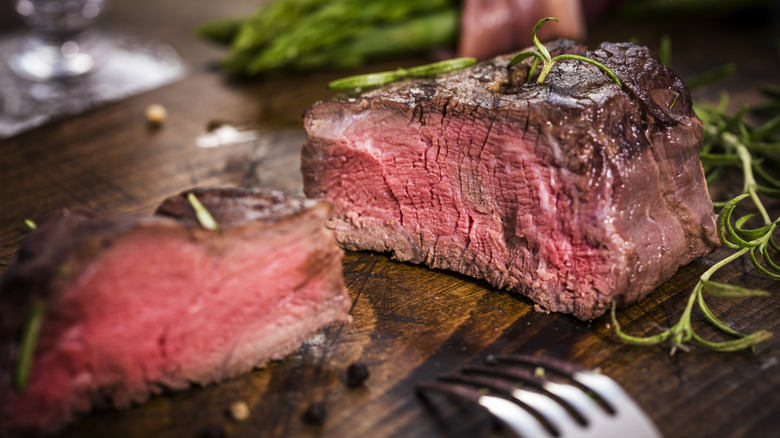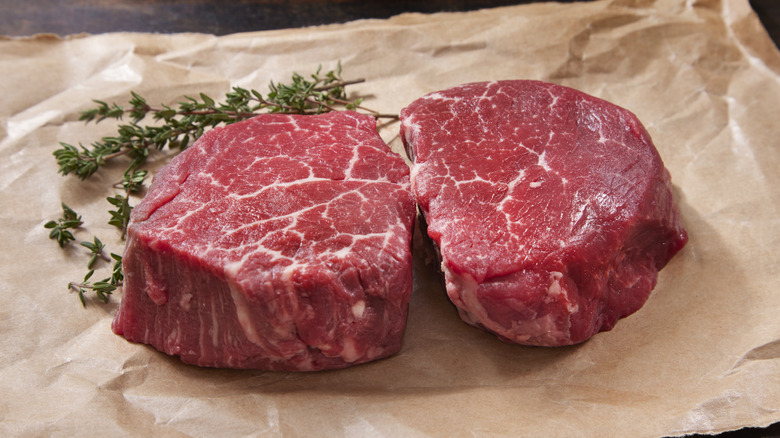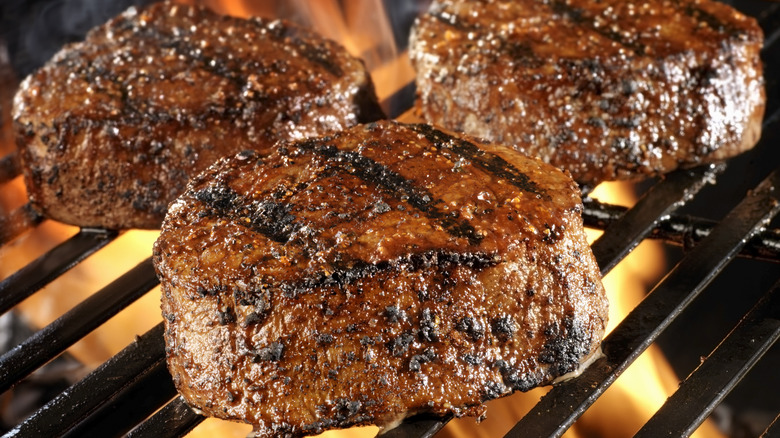How Long To Cook Filet Mignon On The Grill Based On Steak Thickness
By hearing the name alone, most people would instantly associate a filet mignon steak with high-end restaurants and bistros. And rightly so, as it's one of the priciest cuts you can buy to make a steak. A filet mignon is sourced from a very small portion of the cattle's tenderloin (of which each carcass has only two). Since this specific part of the cow doesn't do much work and has very few connective tissues, the meat's texture is incredibly tender — often described as having a "melt-in-your-mouth" creaminess to it.
Properly butchered and trimmed, a filet mignon is about palm-sized, but its thickness can vary depending on your butcher. You can get a thinner filet mignon that's between 1 ½ to 2 inches (a "petit filet") or thicker 3-inch cuts often served at steakhouses.
A 1 ½-inch filet mignon may not look all that different from a 2-inch one on the cutting board. However, they cook very differently. Just half an inch of extra thickness can mean up to five minutes of additional cooking time. It's no fun springing on the pricey steak cut and hoping for medium-rare only to end up with it still rare and a bit bloody on the inside. Here's how to precisely time your steak on the grill to get the result you want!
Pick your cut based on how you like your steak
If you prefer your steak on the rarer side, a thicker, steakhouse-style cut about 2 to 3 inches thick would be ideal. The extra thickness will give your steak's core some insulation, so you can cook it for longer on the grill and sear a nice crust onto it without the center becoming an overcooked mess.
Assuming you're using a gas grill, if you're gunning for a medium-rare steak, cook each side for five minutes under medium-high heat (between 375 and 450 degrees Fahrenheit) while monitoring the internal temperature with a meat thermometer. When it reads between 125 to 135 degrees Fahrenheit, your steak is ready. Don't have a thermometer? You can use the hand trick to test doneness – though far less reliable than a thermometer, it can be helpful in a pinch.
A thinner cut is better if you like your filet mignon medium-well or well-done. While you can still get a medium-rare steak using a thinner cut, however, do note that you won't be able to get as crispy a crust. For a filet mignon between 1½ to 2 inches thick, three and a half to four and a half minutes per side is okay for medium-rare. Add around 30 seconds per side for each level of doneness above that, like five to five and a half minutes per side for medium.
For those using a charcoal grill
For those who use an old-fashioned charcoal grill, though, you'll have a lot more work cut out for you. Unlike gas grill users, who can simply crank a knob to get lower heat, you'll have to manually sift the charcoals to get the correct heat going.
For the gas grill equivalence of medium-high heat, use about half to three-quarters of a chimney starter filled with coals. Cook the steak for around five minutes per side over direct heat, then transfer it over to the cooler side to cook the rest of the way to the right level of doneness on indirect heat. You can use a thermometer to follow its progress and pull it off the grill to rest once it's ready.
If you want better-looking grill marks, fill the chimney with a full charcoal load to get high heat. Flash-sear the steak for two to three minutes each, then transfer over to the indirect heat zone to cook to doneness. Alternatively, you can swap the order around, too, by cooking it to doneness first over indirect heat, and then searing it on direct heat later. This is called a reverse sear, and it's a great trick to use if you don't want to overdo your steak by accident!


